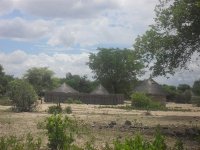 Botswana is often held up as a model of development in Africa and rightfully so. It boasts a strong economy and a stable, vibrant society comprised of many different tribes. Rural Botswana, however (like rural areas the world over) faces many challenges with respect to lack of infrastructure. Issues of health and education also affect the workforce.
Botswana is often held up as a model of development in Africa and rightfully so. It boasts a strong economy and a stable, vibrant society comprised of many different tribes. Rural Botswana, however (like rural areas the world over) faces many challenges with respect to lack of infrastructure. Issues of health and education also affect the workforce.
In the 1980s, the government of the Republic of Botswana devised a program of Community Based Natural Resource Management (CBNRM) with a view to engaging rural communities in the conservation and sustainable use of natural resources in order to improve livelihoods. The idea was that providing local peoples with stewardship of the resources that they use for sustenance and trade would help to address the high levels of rural poverty and unemployment, while simultaneously reversing dangerous levels of unsustainable use of natural resources.
In 2002, the Revised National Policy for Rural Development estimated that 47 percent of all rural households in Botswana could not meet their basic needs. In response, diversifying rural economies once again became a focus of government policy and led to a renewed emphasis on establishing community-based trusts in order to achieve this goal.
There are three types of land tenure in Botswana: state, private and tribal. My work has been focused on tribal land and the rights, obligations and opportunities presented to the communities in the Shakawe area by this type of land occupation. When a community trust is granted tribal land, the beneficiaries gain the right to occupy and use the land and the resources thereon (with the exception of minerals) for traditional and subsistence purposes. This allows the San people — who live in the area — to cultivate wild oranges, harvest thatching grass to roof houses and hunt for game (within prescribed wildlife quotas). In order to commercially exploit the resources found on tribal land, communities can apply for natural resource management leases. These applications are adjudicated by local land boards and, if granted, allow for the operation of sustainable tourism enterprises, harvesting of resources and commercial hunting of wildlife in return for lease and royalty payments to the government.
The work that I have been doing is closely tied to the landscape and the people who live on the Okavango, the world’s largest inland delta. The Okavango River flows into Botswana through Angola and Namibia, creating a unique ecosystem and hosting vast quantities of game and other valuable natural resources. My mandate has been to redraft the constitutions of various community based trusts that fall under the TOCaDI umbrella.
The community trusts are vehicles through which various small communities and cattle posts are represented at a local level. Through them, income-generating programs, land acquisition and private-public partnerships are established. The trusts, just like the land boards, are prohibited from discriminating on tribal, racial, political, religious or ethnic grounds.
Recent legislative changes promoting greater financial accountability of the trusts to their beneficiaries, as well as evolving community demands and the need for broader powers, have rendered the existing trusts invalid and not nearly robust enough to empower the trust to take advantage of growing business opportunities.
The San not only rely heavily on the use of natural resources for their subsistence; for most people in this area, natural resource use is the only form of income they have. In this way, community trusts are central to preserving the natural and cultural heritage of the San people and in helping to alleviate poverty.
Next time: Reflections on my return to Toronto.
FMC lawyer Melissa Ghislanzoni joins us this month to blog about her time working as a volunteer lawyer in Botswana.

